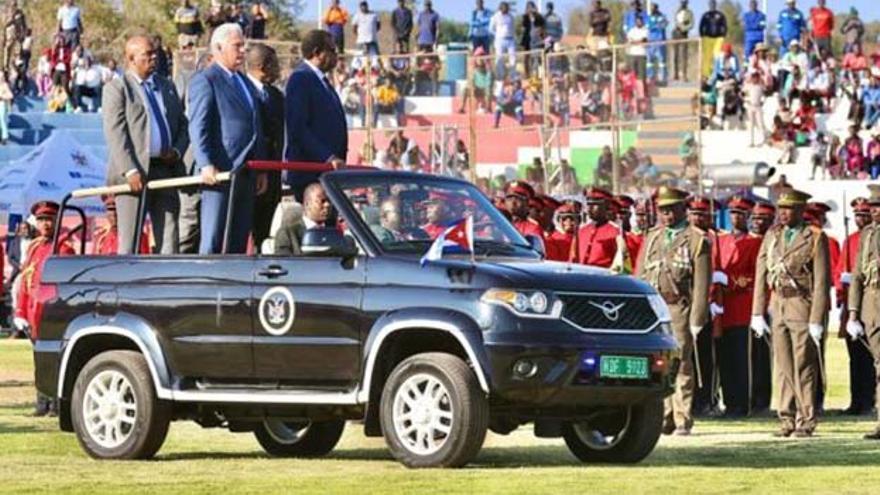
![]() 14ymedio, 27 August 2023 — On the last stop of his tour of Africa, Cuban President Miguel Díaz-Canel arrived this Saturday in Namibia, where he participated in the festive events of Heroes’ Day in commemoration of Namibia’s war of independence. The pomp of the reception contrasted with the lack of information about any agreements signed by both parties.
14ymedio, 27 August 2023 — On the last stop of his tour of Africa, Cuban President Miguel Díaz-Canel arrived this Saturday in Namibia, where he participated in the festive events of Heroes’ Day in commemoration of Namibia’s war of independence. The pomp of the reception contrasted with the lack of information about any agreements signed by both parties.
Díaz-Canel landed at noon in Windhoek, the Namibian capital, with his wife, Lis Cuesta Peraza. At the State House he met with his counterpart, Namibian President Hage Geingob, who welcomed him with a military parade and talked about the friendly relations that exist between the Island and Namibia, according to the official press.
Cubadebate points out that the Cuban leader was the special guest at the commemoration, held at the Independence Stadium. Díaz-Canel and Geingob arrived at the scene in a convertible jeep and toured the facilities while greeting the attendees of the ceremony that commemorates the beginning of the war of independence on August 26, 1966.
During his speech, Díaz-Canel recalled that Cuban soldiers shared a “trench” with Namibians during the fight against the People’s Organization of South West Africa (SWAPO) in the “difficult days of the Angolan war.” “Cuba is honored to have supported them. There was no more honorable path to independence” from apartheid, he said.
The president pointed out that the Cubans who fought in the war along with Namibia can “feel satisfied,” because “their sacrifice contributed decisively to the independence of Angola, which gives its children pride, and Cuba forever won the respect and affection of an ally.”
Díaz-Canel, however, did not mention the Cubans killed in the war, a figure that the ruling party estimates at a little more than 2,000 soldiers killed in African territory. Independent voices question this figure and point to a higher mortality among the more than 350,000 Cubans who participated in those conflicts.
In his speech, the Cuban ruler took the opportunity to refer to the “difficult socio-economic situation” suffered by the Island, derived, according to him, from the economic sanctions of the United States. He thus appreciated the support of the Government of Namibia in the resolutions before the United Nations (UN) against the U.S. blockade.
So far it has not been revealed in the official Cuban press whether Díaz-Canel’s visit resulted in the signing of an economic agreement. During his passage through Angola, Havana and Luanda, he signed an agreement that will allow the installation of Cuban pharmaceutical laboratories in that country, and Angolans will also be able to install one in the Mariel Special Development Zone.
Prensa Latina reported that the Cuban president ratified the “will” to strengthen cooperation and increase efforts in the areas of construction, sports, culture and computing (such as artificial intelligence and robotics). This will happen, the text points out, if Namibia “needs it.”
During the festivities, Díaz-Canel received the Order of the Ancient Welwitschia Mirabilis, the highest decoration of Namibia and the same one that in March 2008 was given to Fidel Castro for “his support for the African liberation struggles,” especially the uprising to achieve Namibia’s independence from South Africa.
Prior to his arrival in Windhoek, Díaz-Canel had visited Mozambique and Angola, after attending the summit of the BRICS group of emerging economies (Brazil, Russia, India, China and South Africa), held from August 22 to 24 in Johannesburg.
Translated by Regina Anavy
____________
COLLABORATE WITH OUR WORK: The 14ymedio team is committed to practicing serious journalism that reflects Cuba’s reality in all its depth. Thank you for joining us on this long journey. We invite you to continue supporting us by becoming a member of 14ymedio now. Together we can continue transforming journalism in Cuba.
